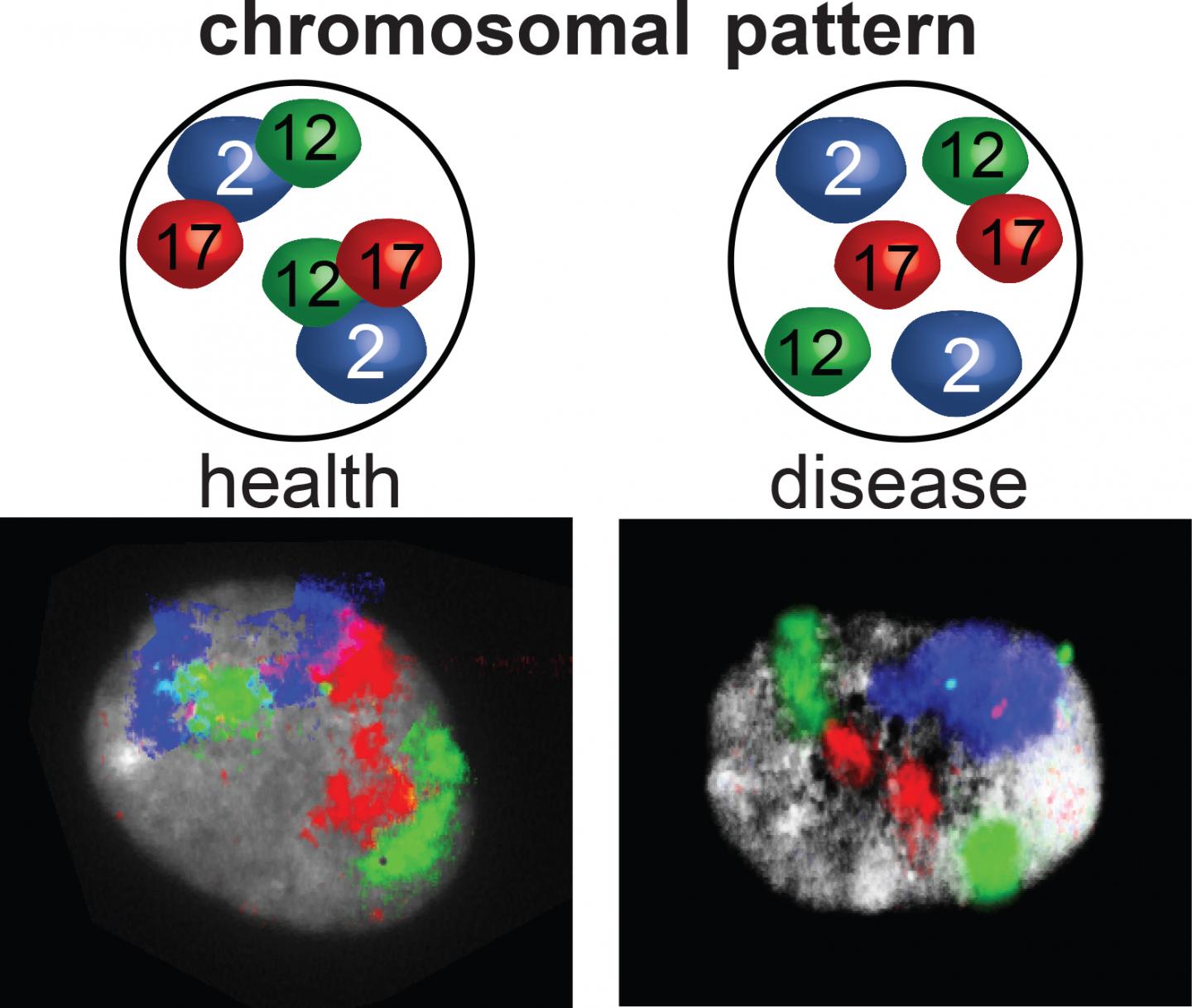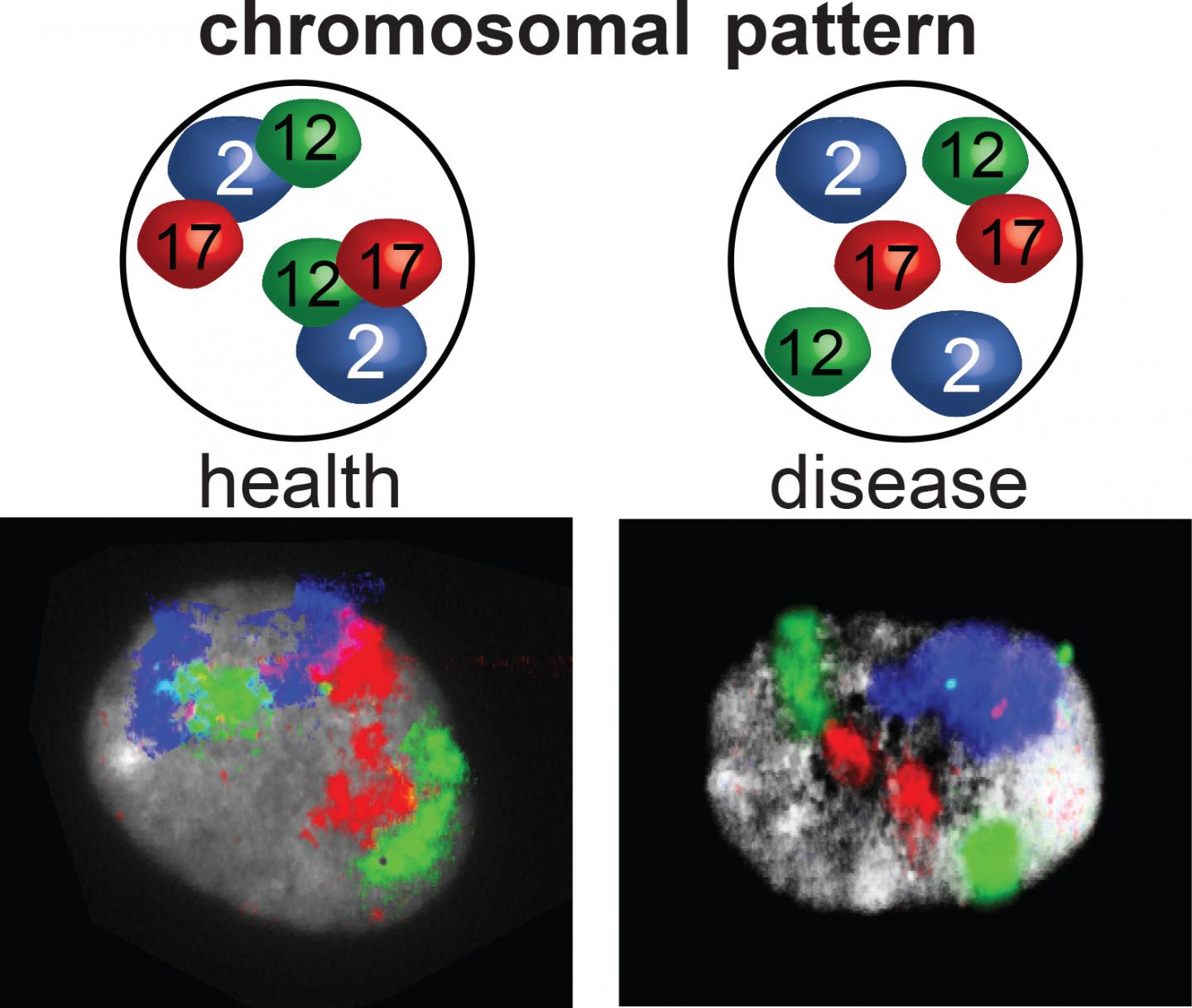
Credit: Luft Lab, MDC
How are chromosomes arranged in the cell nucleus? Is it possible that they communicate with one another by "touching" each other? To answer this question and to shed more light on the fundamental properties of the communication between different chromosomes, Philipp Maass from Friedrich Luft's lab at the Max Delbrück Center for Molecular Medicine in the Helmholtz Association (MDC) and Experimental and Clinical Research Center (ECRC), Berlin, and Anja Weise, University of Jena, have explored the interactions between chromosomes 12 and 17 in their latest project, published in the EMBO Journal.
Philipp Maass was fascinated by previous findings that genes on different chromosomes interact with one another. Specifically, the long non-coding RNA locus CISTR-ACT on human chromosome 12 "kisses" (contacts) the SOX9 gene on chromosome 17. Therefore, Philipp Maass and Anja Weise explored if these contacts occur frequently in different cells of different individuals and how the interactions of the entire chromosomes 12 and 17 look like.
Inter-chromosomal contacts are pivotal for genome organization and gene regulation, but so far, they remain poorly understood. Using human stem cells and derived cells, Friedrich Luft and his team determined that the interactions between chromosomes 12 and 17 occur frequently across different individuals in recurrent patterns. Even in different cells (i.e. fat, bone, cartilage cells, etc.) of the same individual, the two chromosomes communicated to similar extents and with similar shapes.
A family with short fingers helped with the research
Friedrich Luft and his team have been studying hypertension with brachydactyly (short fingers), but also patients with brachydactyly that did not have hypertension. Now, Philipp Maass and Anja Weise asked if a chromosomal alteration can change these determined inter-chromosomal contacts that they had studied in normal nuclei of healthy individuals. Thus, they recruited a three-generation family with brachydactyly that has a deletion on the long arm of chromosome 2 (2q37-deletion syndrome), which comprises the histone deacetylase 4 (HDAC4) gene.
They asked if this HDAC4 deletion can alter the inter-chromosomal communication and supports the shortening of the patients' fingers. Of note, the team detected that chromosomal interactions occurred between three chromosomes: 2, 12 and 17 in normal nuclei and in nuclei of brachydactyly patients with the HDAC4 deletion. But, the HDAC4 deletion resulted in displaced inter-chromosomal arrangements and disturbed interactions between the three chromosomes. Therefore, the investigators propose a direct link between structural chromosomal aberration and altered nuclear architecture that results in a human genetic condition.
Friedrich Luft and Philipp Maass suggest that these findings about inter-chromosomal communication driving gene regulation and genome organization are highly important for understanding genome organization and disease progression.
###
Press contact:
Prof. Friedrich Luft
Max Delbrück Center for Molecular Medicine in the Helmholtz Association and
Experimental and Clinical Research Center (ECRC), Berlin
Head of research group "Genetics, Nephrology, Hypertension, and Vascular Injury"
Email: [email protected]
Philipp G. Maass, Ph.D.
Harvard University
SCRB – Stem Cell and Regenerative Biology
Email: [email protected]
Dr. Annette Tuffs
Max Delbrück Center for Molecular Medicine in the Helmholtz Association
Head of Communications
Phone: 030 – 9406 – 2140
[email protected]
Reference:
Philipp Maass et al (2018): "Reorganization of inter-chromosomal interactions in the 2q37-deletion syndrome". The EMBO Journal, doi: 10.15252/embj.201696257
The Max Delbrück Center for Molecular Medicine (MDC)
The Max Delbrück Center for Molecular Medicine in the Helmholtz Association (MDC) was founded in Berlin in 1992. It is named for the German-American physicist Max Delbrück, who was awarded the 1969 Nobel Prize in Physiology and Medicine. The MDC's mission is to study molecular mechanisms in order to understand the origins of disease and thus be able to diagnose, prevent and fight it better and more effectively. In these efforts the MDC cooperates with the Charité – Universitätsmedizin Berlin and the Berlin Institute of Health (BIH) as well as with national partners such as the German Center for Cardiovascular Research and numerous international research institutions. More than 1,600 staff and guests from nearly 60 countries work at the MDC, just under 1,300 of them in scientific research. The MDC is funded by the German Federal Ministry of Education and Research (90 percent) and the State of Berlin (10 percent), and is a member of the Helmholtz Association of German Research Centers. http://www.mdc-berlin.de
Media Contact
Dr. Annette Dr. Tuffs
[email protected]
030-940-62533
http://www.mdc-berlin.de
Original Source
http://emboj.embopress.org/content/early/2018/06/13/embj.201696257 http://dx.doi.org/10.15252/embj.201696257





